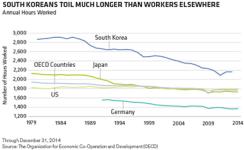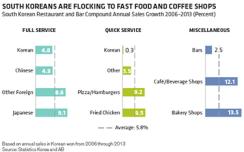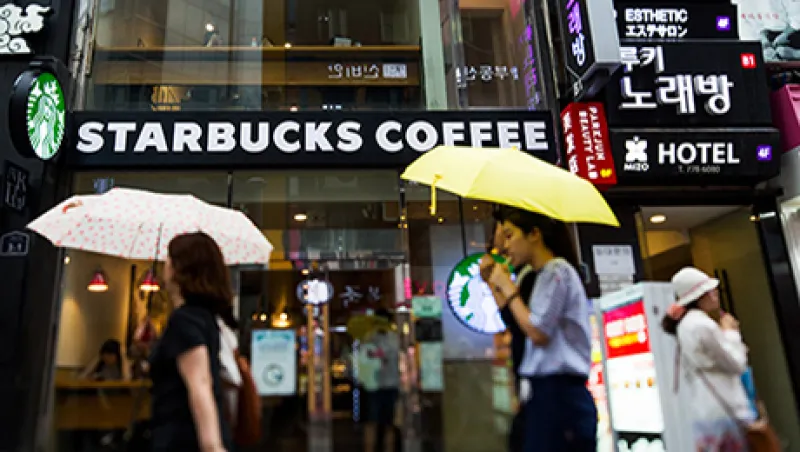South Koreans are starting to kick back and take life a bit easier — and it’s already fostering brisk growth across a wide swath of consumer-focused businesses. Investors, take note.
Mind you, South Koreans are still the world champs of hard work. According to online travel agency Expedia’s 2014 Vacation Deprivation study, they took only seven of their allowed 15 days of vacation in 2014, well below the average of 19.5 days in the 24 nations covered. All told, South Koreans worked nearly 25 percent longer than their developed-market counterparts that year. But those hours of toil have been declining steadily for the past several decades and are now 25 percent below the level of the mid-1980s (see chart 1).

Expect them to continue trending lower. Both the government and large Korean companies have launched campaigns to encourage workers to take more time off, prompted by signs that this excessive industriousness was taking a heavy societal toll. Long hours have not translated into greater productivity. Overwork has also been linked to the country’s high rates of suicide and industrial injury. At the same time, it is important to note that fewer work hours haven’t meant smaller paychecks. According to government statistics, a full-time Korean worker earned an average 3.4 million won ($3,229) a month in 2014, up from 2.8 million won in 2008, despite a 4 percent drop in hours worked. More cash to spend on fun.
The cultural impact has been striking. A recent study found that since 1999, South Koreans have been sleeping 9 percent more, taking 25 percent longer to eat and devoting 35 percent more time to personal care and healthy activities. Spending on entertainment, such as hobbies, books, travel and going to movies and sporting events, has risen at a 4.4 percent annual clip since 2004, outpacing the 3.8 percent annual increase in overall consumer spending.
We see plenty of ways that investors can capitalize on these trends. The most obvious beneficiaries are travel-related businesses. The number of South Koreans flying to international destinations has nearly tripled, from 6 million in 2001 to 16 million in 2014. Unlike travelers elsewhere, Koreans much prefer packaged tours to nonpackaged travel, as would-be travelers don’t like being caught making vacation plans too far in advance (selecting package tours minimizes the need for people to organize the logistics of their own travel) and often includes Korean-speaking tour guides. Spending on these tours has been climbing 12 percent a year since 2004. Interestingly, studies found that fewer than 40 percent of Korean adults have ever traveled abroad. But as more in the country take advantage of their time off, we expect such trips to lure a broader cross-section of the population.
One of the best barometers of South Korea’s shift toward a more laid-back lifestyle is the soaring attendance at Lotte World. Opened in 1989, the Seoul recreation complex encompasses shopping malls, movie theatres, a folk museum, a luxury hotel and the world’s largest indoor theme park. It received 7.6 million visitors in 2014, nearly double the level five years earlier.
South Koreans are also spending more on dining out. Among the fastest-growing segments are coffee and beverage shops, where annual sales have been growing at twice the pace of restaurant sales overall (see chart 2). A recent government survey reported that South Koreans consume coffee nearly as often as they do the traditional side dish kimchi, and twice as frequently as they do white rice. South Korea now ranks fourth among countries in terms of numbers of Starbucks locations per person.

Tastes and eating habits are changing as well. Sales at fast-food pizza, hamburger and fried-chicken restaurants are also outpacing the total restaurant average. Fried chicken in particular is wildly popular in the country, and Korean-style fried chicken has made inroads abroad.
Koreans’ workaholic tendencies are deeply ingrained in the national psyche. Yet given the concerted institutional push and the obvious economic positives, we expect South Koreans’ enthusiasm for leisure to continue to grow. In turn, we see investment opportunities increasingly shifting from the better-known South Korean auto and technology chaebol to the more domestically driven businesses across the retail, entertainment, travel and other consumer services industries. The trend in the country toward a better work-life balance is likely to influence investment in the country for years to come.
Sammy Suzuki is portfolio manager of strategic core equities at AllianceBernstein in New York.
See AllianceBernstein’s disclaimer.
Get more on equities.






